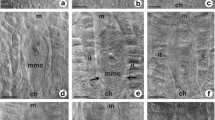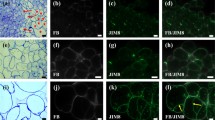Abstract
A study of callase activity in relation to cytogenetical expressions in cytoplasmic male sterile and male fertile Petunia indicated differential timing of the localized enzyme activity. Enzyme activity was determined by a new test. The possible relations between the mode of action of the extrachromosomal gene, timing of the enzyme activity, and male sterility are discussed.
Similar content being viewed by others
References
Brooks, M. H. (1962). Comparative analysis of some of the free amino acids in anthers of fertile and genetic cytoplasmic male sterile sorghum. Genetics 47 1629.
Dubey, D. L., and Singh, S. P. (1965). Mechanism of pollen abortion in three male sterile lines of flax (Linum usitatissimum L.). Crop Sci. 5 121.
Echlin, P. (1968). Pollen. Sci. Am. 218 80.
Edwardson, J. R. (1962). Cytoplasmic differences in T-type cytoplasmic male sterile corn and its maintainer. Am. J. Botany 49 184.
Edwardson, J. R., and Warmke, H. E. (1967). Fertility restoration of cytoplasmic male sterile petunia. J. Heredity 58 195.
Eschrich, W. (1961). Untersuchungen über den Ab- und Aufbau der Callose. Z. Botan. 49 153.
Eschrich, W. (1964). Die Callosesynthese bei Pollenmutterzellen von Cucurbita ficifolia. In Linskens, H. F. (ed.), Pollen Physiology and Fertilization, North Holland Publ. Co., Amsterdam, p. 48.
Ewart, L. C., and Walker, D. E. (1958). Pollen restoration in cytoplasmic male sterile petunias. Am. Soc. Hort. Sci. 55th Meeting, p. 62 (Abstr.).
Frankel, R. (1956). Graft-induced transmission to progeny of cytoplasmic male sterility in petunia. Science 124 684.
Frankel, R. (1962). Further evidence on graft induced transmission to progeny of cytoplasmic male sterility in petunia. Genetics 47 641.
Heslop-Harrison, J. (1964). Cell wall, cell membranes and protoplasmic connections during meiosis and pollen development. In Linskens, H. F. (ed.), Pollen Physiology and Fertilization, North Holland Publ. Co., Amsterdam, p. 39.
Ross, H. (1948). Über die Verschiedenheiten des dissimilatorischen Stoffwechsel in reciproken Epilobium-Bastarden und die physiologisch-genetische Ursache der reciproken Unterschiede. V. Über die Peroxydase-activität in gehemmten und enthemmten Wuchsformen reciproken Epilobium-Bastarden mit der hirsutum Sippe Jena. Z. Induktive Abstammungs- Vererbungslehre 82 187.
Vasil, I. K. (1967). Physiology and cytology of anther development. Biol. Rev. 4 327.
Waterkeyn, L. (1964). Callose microsporocytaire et callose pollinique. In Linskens, H. F. (ed.), Pollen Physiology and Fertilization, North Holland Publ. Co., Amsterdam, p. 52.
Author information
Authors and Affiliations
Additional information
Paper No. 1360-E, 1968 Series of the Volcani Institute of Agricultural Research. Supported in part by grant No. FG-Is-171 of the United States Department of Agriculture, Authorized by U.S. Public Law 480.
Deceased.
Rights and permissions
About this article
Cite this article
Frankel, R., Izhar, S. & Nitsan, J. Timing of callase activity and cytoplasmic male sterility in Petunia . Biochem Genet 3, 451–455 (1969). https://doi.org/10.1007/BF00485605
Received:
Revised:
Issue Date:
DOI: https://doi.org/10.1007/BF00485605




